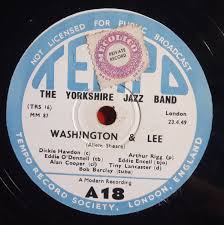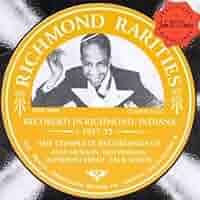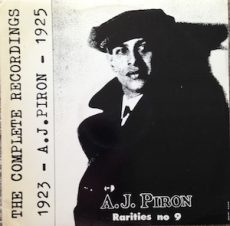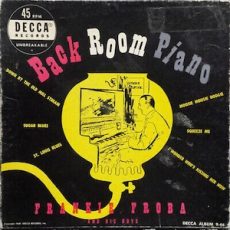
Daily Dose Of Jazz…
Richard Hawdon was born in Leeds, England on August 27, 1927 and first studied cello before moving to trumpet in his mid-teens. After a stint with the Yorkshire Jazz Band he relocated to London, England in 1951, signing on with Chris Barber’s famed New Orleans Jazz Band.
Hawdon replaced trumpeter Ken Colyer in the Christie Brothers Stompers in 1952, remaining with the group for close to two years. While his Louis Armstrong-inspired approach earned favor among traditional jazz purists, he developed a modernist sensibility influenced by Clifford Brown.
Bop and progressive jazz followed in 1954 as a member of Don Rendell’s group in addition to a stint as trumpeter and arranger with Tubby Hayes. He joined his first big band in mid-1956 with Basil and Ivor Kirchin and the next year he joined John Dankworth in 1957. This would be his longest and most rewarding career collaboration.
Beyond recordings with Dankworth, the group performed with Louis Armstrong, teamed with the Duke Ellington Orchestra, he wrote and arranged a number of Dankworth staples including Cool Kate and One for Janet. Hawdon went on to freelance with bandleaders Sid Phillips, Harry Gold, Oscar Rabin, Terry Lightfoot, and backed singers Tony Bennett and Eartha Kitt during a stint with the house band at the London cabaret Talk of the Town.
On the eve of the demise of jazz as the leading music of the era, Dick relocated to Yorkshire, England in 1967 and led the Batley Variety Club’s house band. A year later, he developed a jazz course at the new City of Leeds College of Music, and became head of the school’s Light Music Department in 1972. Hawdon also led his own jazz quintet throughout the 1980s, and after retiring from academia in 1993 he turned his attention to the bass, playing in a series of local groups.
Trumpeter and bassist Dick Hawdon died June 24, 2009.
More Posts: bandleader,bass,history,instrumental,jazz,music,trumpet

Daily Dose Of Jazz…
Alphonse “Alphonso” Trent was born on August 24, 1905 in Fort Smith, Arkansas and played piano from childhood, working in local bands in Arkansas through his youth.
He led his first band in the mid-1920s, possibly as early as 1923. In 1924 he played with Eugene Cook’s Synco Six, then took over leadership of the band until 1934. They played mostly in the American South and Midwest, as well as on steamboats.
Despite success in New York around 1930, Trent chose not to work further on the East Coast. He left music in the mid-1930s but returned with another band in 1938. His sidemen included Terrence Holder, Alex Hill, Stuff Smith, Snub Mosley, Charlie Christian, Sweets Edison, Mouse Randolph, and Peanuts Holland.
As a leader he only recorded eight sides: four in 1928, two in 1930, and two in 1933. His small recorded legacy has made him a somewhat obscure figure today, but the sophistication of his arrangements and the precision with which they were executed inspired awe in contemporaries.
Pianist and territory band leader Alphonso Trent, who performed in the biggest and finest hotels in the South, died on October 14, 1959.
More Posts: bandleader,history,instrumental,jazz,music,piano

Daily Dose Of Jazz…
Armand John “A.J.” Piron was born on August 16, 1888 in New Orleans, Louisiana to Octave Louis Piron and Marie Jeanne Zeringue. At home he spoke English and French patois, and grew up steps from Claiborne Avenue, which at that time was a bustling, tree-lined center of commerce and community life. His father, a shoemaker, was also a musician and music teacher and played in the Philharmonic Orchestra. He taught his sons Milford, Albert, and Armand how to play.
At the age of seven Piron had an accident that damaged one of his legs. For the next five years while he recovered, he devoted himself to practicing the violin. This could be the reason he didn’t join the numerous New Orleans marching bands popular at that time. Instead became a dance and concert band musician and at age twelve he made his musical debut by joining a band his father led that included some of his students and his brothers.
In 1903 A.J. began playing in the Bloom Philharmonic. In 1908 he played for the Peerless Orchestra. Then in 1913 he played in the large, legendary orchestra organized by John P. Robichaux for the Carnival ball of the Elves of Oberon. That same year he played at the Rose Bud Theater on Dryades Street, sometimes with Papa Celestin’s Tuxedo band. He also played in the Olympia Band with Sydney Bechet, Kid Ory, Louis Keppard, and Clarence Williams, among others.
After touring briefly with W.C. Handy in 1917, Piron started an orchestra which included Lorenzo Tio, Steve Lewis, John Lindsay, and Peter Bocage. The theme song of the orchestra was The Purple Rose of Cairo, written by Piron and Steve Lewis. In 1923, Piron took his band to New York City.
Violinist A.J. Piron, who led dance bands during the 1910s through the 1930s, died on February 17, 1943 in New Orleans.
More Posts: bandleader,history,instrumental,jazz,music,violin

Daily Dose Of Jazz…
Frank Froeba was born August 6, 1907 in New Orleans, Louisiana. While still in his teens he held jobs in the bands of Johnny Wiggs and John Tobin. By the age of 17 he played with Johnny de Droit in New York City in 1924-1925, then led his own band in Atlantic City, New Jersey.
In the latter half of the decade Frank moonlighted in other dance ensembles. He recorded with Jack Purvis in 1930 and with Jack Bland in 1932, then worked with Benny Goodman from 1933 to 1935. This was followed in 1935 to 1944 where he led his own band and played on recordings for Columbia and Decca. Among his sidemen were Bunny Berigan, Jack Purvis, Bobby Hackett and Joe Marsala.
He was a house pianist for Decca in the 1930s and 1940s, playing behind Bob Howard and Lil Armstrong, among others. In 1955, he moved to Miami, Florida and performed as Frank Froba, moving more into popular performance.
One of his more popular tracks, Jumpin’ Jive, which he co-wrote with Cab Calloway. It was recorded by Joe Jackson on his Joe Jackson’s Jumpin’ Jive album.
Pianist and bandleader Frank Froeba died on February 16, 1981 in Miami.
More Posts: bandleader,history,instrumental,jazz,music,piano

Daily Dose Of Jazz…
Floyd Maurice “Stumpy” Brady was born on August 4, 1910 in Brownsville, Pennsylvania. At the end of the 1920s he performed and recorded with Zack Whyte’s Chocolate Beau Brummels before touring with Al Sears. During the next decade he played with Andy Kirk in New York, recorded with Blanche Calloway, and returned briefly to Whyte’s band in 1933.
He replaced Ed Cuffee in McKinney’s Cotton Pickers, and then performed and recorded with Claude Hopkins from 1936 to 1938 and Teddy Wilson from 1939 to 1940. As a member of the Lucky Millinder orchestra, Stumpy played a solo while accompanying Sister Rosetta Tharpe in the soundie Lonesome Road in 1941.
Other musicians and bandleaders he worked with include Al Sears, Count Basie, Joe Guy touring with Billie Holiday in 1945, Jay McShann, Fletcher Henderson, Roy Eldridge, and Cat Anderson. After a period of inactivity in the 1950s, Brady resumed playing in the 1960s with Slide Hampton’s band, Luckey Roberts’s orchestra, and Edgar Battle’s big band.
Trombonist Stumpy Brady died on February 11, 1998.
More Posts: history,instrumental,jazz,music,trombone


